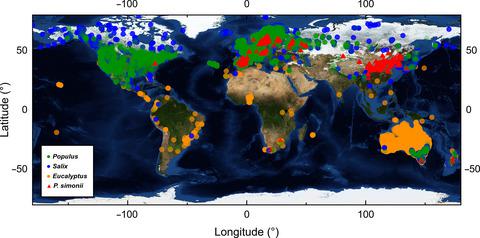当前位置:
X-MOL 学术
›
GCB Bioenergy
›
论文详情
Our official English website, www.x-mol.net, welcomes your
feedback! (Note: you will need to create a separate account there.)
Ecologically adaptable Populussimonii is specific for recalcitrance‐reduced lignocellulose and largely enhanced enzymatic saccharification among woody plants
Global Change Biology Bioenergy ( IF 5.9 ) Pub Date : 2020-10-09 , DOI: 10.1111/gcbb.12764 Zhengyi Lv 1, 2 , Fei Liu 1, 2 , Youbing Zhang 1, 2 , Yuanyuan Tu 1, 2 , Peng Chen 1, 2 , Liangcai Peng 1, 2
Global Change Biology Bioenergy ( IF 5.9 ) Pub Date : 2020-10-09 , DOI: 10.1111/gcbb.12764 Zhengyi Lv 1, 2 , Fei Liu 1, 2 , Youbing Zhang 1, 2 , Yuanyuan Tu 1, 2 , Peng Chen 1, 2 , Liangcai Peng 1, 2
Affiliation

|
Woody plants provide enormous biomass resource convertible for biofuels and bioproducts, but they are of typical lignified secondary cell walls with strong recalcitrance against biomass degradation. It thus becomes critical to find out the desirable woody plant enabled for efficient biomass enzymatic saccharification. In this study, we collected totally seven biomass samples from three major hardwood species showing worldwide geographic distributions and diverse cell wall compositions. Under acid (H2SO4) and alkali (NaOH, CaO) pretreatments, all biomass samples showed remarkably enhanced enzymatic saccharification, but the Populus simonii species had the highest hexoses yields from all pretreatments performed. In particular, the mild and green‐like pretreatment (10% CaO, 50°C) could lead to more than 70% cellulose degradation into fermentable hexoses in the P. simonii species, but only 24%–38% cellulose digestions were examined in the other six samples. Importantly, the P. simonii species is of the lowest ratios of lignin S/G and hemicellulose Xyl/Ara among seven samples, being two major factors accountable for much improved lignocellulose recalcitrance. These consequently caused the most reduced cellulose DP in the pretreated P. simonii residues for enhanced biomass saccharification. Furthermore, this study performed a genome‐wide profiling of gene expression to confirm distinct wall polymer biosynthesis and biomass metabolism in the P. simonii species, consistent with its significantly improved lignocellulose recalcitrance. Therefore, this study has found out the desirable model of woody plants for efficient biomass enzymatic saccharification under cost‐effective and green‐like pretreatments, providing a powerful strategy for genetic lignocellulose modification in woody plants and beyond.
中文翻译:

具有生态适应性的胡杨(Populussimonii)专用于木本植物中顽固减少的木质纤维素和大大增强的酶促糖化作用
木本植物提供了可转换为生物燃料和生物产品的巨大生物量资源,但它们具有典型的木质化次生细胞壁,对生物质降解具有强烈的抵抗力。因此,找到能够实现有效生物质酶促糖化的理想木本植物变得至关重要。在这项研究中,我们从三个主要的硬木树种中收集了总共七个生物量样品,这些样品显示了全球地理分布和不同的细胞壁组成。在酸(H 2 SO 4)和碱(NaOH,CaO)预处理下,所有生物量样品均显示出显着增强的酶促糖化作用,但西杨(Populus simonii)进行所有预处理后,该物种的己糖产量最高。特别是,温和的绿色预处理(10%CaO,50°C)可能导致simonii物种中超过70%的纤维素降解为可发酵己糖,但仅对24%–38%的纤维素消化进行了检测。其他六个样本。重要的是,在7个样品中,小叶小球藻木质素S / G和半纤维素Xyl / Ara的比率最低,这是导致木质纤维素抗拒性大大提高的两个主要因素。因此,这些导致在预处理的西门氏疟原虫中纤维素DP减少最多。残留物以增强生物质糖化作用。此外,这项研究对基因表达进行了全基因组分布分析,以确认西蒙氏疟原虫物种中独特的壁聚合物生物合成和生物量代谢,与其木质纤维素的顽固性显着提高相一致。因此,本研究发现了木本植物在经济高效且类似于绿色的预处理下进行有效生物量酶促糖化的理想模型,为木本植物及其他植物中的遗传木质纤维素改性提供了强有力的策略。
更新日期:2020-10-09
中文翻译:

具有生态适应性的胡杨(Populussimonii)专用于木本植物中顽固减少的木质纤维素和大大增强的酶促糖化作用
木本植物提供了可转换为生物燃料和生物产品的巨大生物量资源,但它们具有典型的木质化次生细胞壁,对生物质降解具有强烈的抵抗力。因此,找到能够实现有效生物质酶促糖化的理想木本植物变得至关重要。在这项研究中,我们从三个主要的硬木树种中收集了总共七个生物量样品,这些样品显示了全球地理分布和不同的细胞壁组成。在酸(H 2 SO 4)和碱(NaOH,CaO)预处理下,所有生物量样品均显示出显着增强的酶促糖化作用,但西杨(Populus simonii)进行所有预处理后,该物种的己糖产量最高。特别是,温和的绿色预处理(10%CaO,50°C)可能导致simonii物种中超过70%的纤维素降解为可发酵己糖,但仅对24%–38%的纤维素消化进行了检测。其他六个样本。重要的是,在7个样品中,小叶小球藻木质素S / G和半纤维素Xyl / Ara的比率最低,这是导致木质纤维素抗拒性大大提高的两个主要因素。因此,这些导致在预处理的西门氏疟原虫中纤维素DP减少最多。残留物以增强生物质糖化作用。此外,这项研究对基因表达进行了全基因组分布分析,以确认西蒙氏疟原虫物种中独特的壁聚合物生物合成和生物量代谢,与其木质纤维素的顽固性显着提高相一致。因此,本研究发现了木本植物在经济高效且类似于绿色的预处理下进行有效生物量酶促糖化的理想模型,为木本植物及其他植物中的遗传木质纤维素改性提供了强有力的策略。











































 京公网安备 11010802027423号
京公网安备 11010802027423号